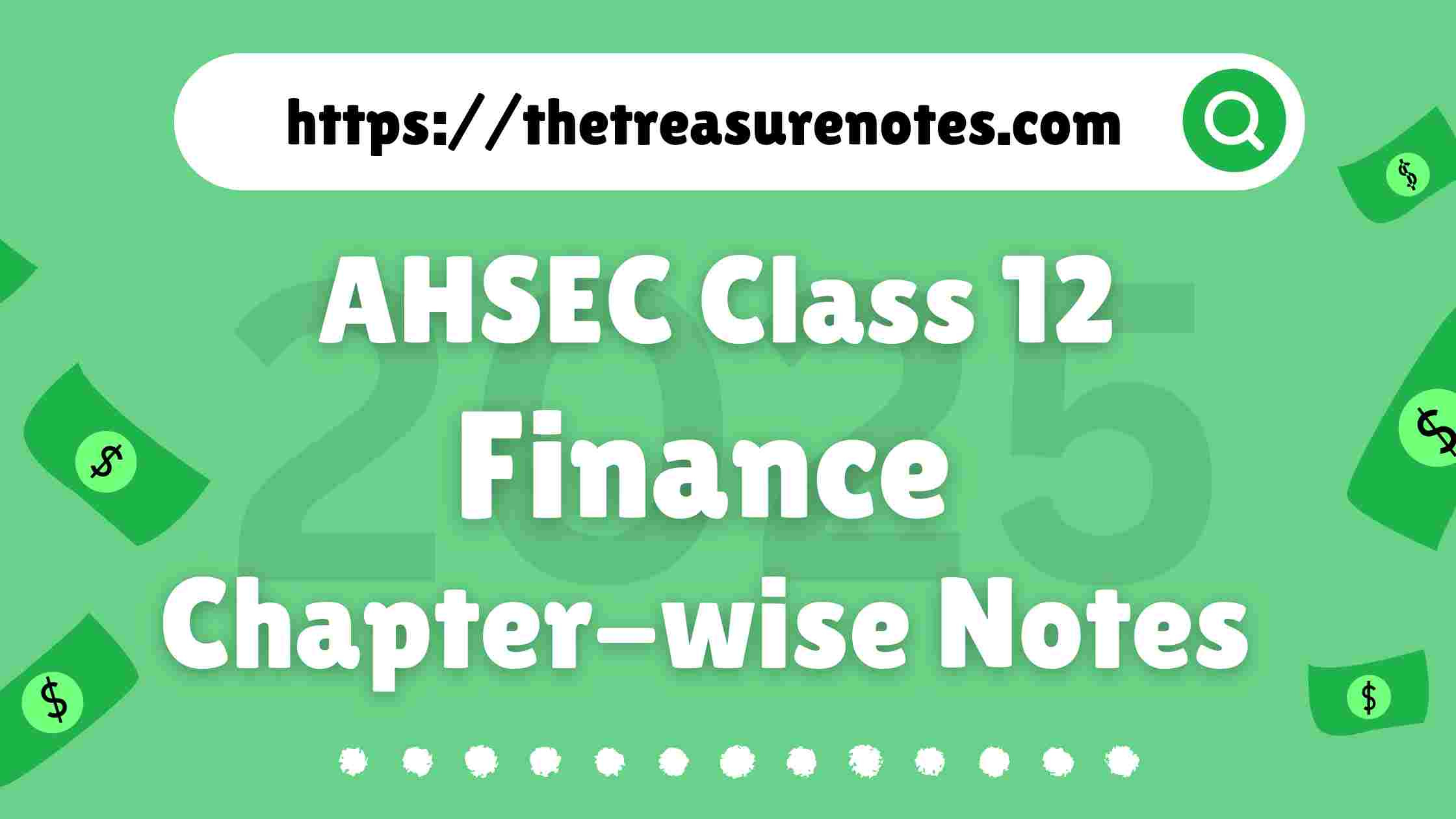Get AHSEC Class 12 Finance Chapter: 13 MODERN BANKING SERVICES Important Questions Answers 2025.
In this Post we have provided Unit IV: Financial Services HS 2nd Year Finance Chapter: 13 MODERN BANKING SERVICES Important Notes with Marked/highlighted previous year questions asked in AHSEC Examination.
AHSEC Class 12 Finance Notes
Chapter: 13 MODERN BANKING SERVICES
CHAPTER-13 MODERN BANKING SERVICES
1. Discuss the Modern banking services which banks use as a channel?
Ans: Modern banking services have transformed the way we manage our finances, offering a range of convenient channels for transactions and interactions. Credit cards, debit cards, e-banking, mobile banking and ATMs are some of the key avenues through which banks provide their services.
i. Credit Cards: Credit cards are convenient tools that allow users to make purchases on credit, paying back the borrowed amount later. They offer financial flexibility and often come with rewards and benefits.
li. Debit Cards: Debit cards provide immediate access to our bank funds, allowing us to make purchases and withdraw cash directly from our account. They are secure and offer transactional convenience.
iii. E-Banking: E-Banking enables us to carry out banking activities anytime and anywhere through electronic platforms. It offers services like fund transfers, bill payments and account management online.
iv. Mobile Banking: Mobile banking lets us perform banking tasks using smartphones or mobile devices. It provides access to accounts, fund transfers, bill payments and more, enhancing banking convenience on the go.
V. ATMs (Automated Teller Machines): ATMs allow us to withdraw cash, deposit money, transfer funds and perform various transactions round the clock. They provide instant access to banking services without visiting a physical branch.
2. Write short notes on: a. credit card b. debit card c. Mobile Banking d. e-banking
Ans: a. Credit Card: A credit card is a small plastic card that allows us to buy things on credit, meaning we can pay for the bought items/articles later. The bank that gives us the card with the help of which we can pay for our purchases. In case of credit cards we have to give the money back to the bank/credit card issuing company within a certain number of days. If we pay the bank back on time, they don’t charge anything extra from us. But if we take longer to give the money back, the bank will add extra money called “interest.” Our credit card has our names and a special number on it. We also need to create a secret PIN number for our card. This keeps our card safe, confidential and private.
b. Debit Card: A debit card is a small plastic card that allows us to make payments, withdraw money from ATMs and access various banking services. It’s similar to a credit card, but we can only use it for transactions if we have enough money in our account. When we buy something or use a service, the money is immediately taken out of our account. To use a debit card, we need to create a PIN, a secret code. It’s recommended to change this code regularly for safety. Debit cards come in different types, like Maestro, Visa Debit, RuPay and Mastercard, each with its own features.
c. Mobile Banking: Mobile banking is a service provided by banks that lets us do financial tasks using our smartphone or tablet. It’s different from internet banking because it uses a special app provided by the bank. This service is available 24/7. With mobile banking, we can do almost everything we do in a bank. To use it, we create a six-digit passcode called an MPIN using the bank’s mobile app. We can only use this service on the phone number registered with the bank. Mobile banking works based on the mobile’s internet connection. We can send money, ask questions, order cheques, apply for loans or insurance, all through this app. It’s a cost-effective way to include more people in banking.
d. E-banking: (see Ans to gsn no. 4)
3. Differentiate between Debit Card and Credit Card.
Ans: The following are the differences between Debit Card and Credit Card:
| Basis | Debit card | Credit card |
| Source fund | It is linked to our bank account, using our available funds. | It allows us to borrow money from the card issuer, within a set credit limit. |
| Payment | Money is directly deducted from our account for payments | We borrow money and pay it back later, usually monthly. |
| Credit limit | There is no credit limit, (as we use our own money.) | It has a defined credit limit for borrowing. |
| Borrowing | Here we don’t borrow; we spend our own money. | We borrow money from the credit card company. |
| Interest | No interest is charged (since it’s our own money) | If we don’t pay the full amount, interest is charged on the remaining balance. |
4. What do you mean by E-Banking? What are its functions?
Ans: E-Banking, or electronic banking, is a modern way that banks use to offer their services. It allows customers to do banking activities from anywhere and at any time. E-banking is a secure, fast and convenient electronic service that lets customers access their bank accounts and perform online banking tasks 24 hours a day, 7 days a week.
E-Banking uses telecommunications and electronic networks to handle transactions and provide financial services. All we need for E-Banking is access to the internet. It goes by various names like web-based banking, virtual banking and online banking. E-Banking services include card banking, internet banking, phone banking, mobile banking and electronic fund transfers. E-Banking offers many useful functions that make banking easier, they are:
(a) Financial Transactions: We can complete various financial transactions through E-Banking.
(b) Fund Transfers: E-Banking allows us to move money from one account to another, even between different banks,
(c) Transaction Statements: We can access statements detailing our transactions.
(d) Account Balances: It lets us check our bank account balances and loan balances.
(e) Online Purchases: E-Banking enables us to buy things online and make immediate payments.
(f) Request Services: We can request services like ordering a chequebook, ATM card, or credit card through E-Banking.
5. What are the Merits/Advantages and Demerits/Disadvantages of E-Banking?
Ans:- Merits/Advantages of E-Banking: (a) Convenience: E-Banking is incredibly convenient as it lets us perform transactions and banking tasks without visiting a physical bank branch.
(b) Cost Savings: It is cost-effective for both banks and customers due to reduced operational expenses and nominal fees.
(c) 24/7 Availability: E-Banking operates round the clock, allowing transactions anytime throughout the week.
(d) Security: E-Banking is secure since outsiders can not access our account without the PIN. Keeping the PIN secret is crucial.
(e) Comprehensive Services: It offers a wide array of services like payments, purchases, account viewing and more.
Demerits/Disadvantages of E-Banking:
(a) Not Universal: E-Banking is useful for people who like using technology, but it might not be good for those who aren’t comfortable with it.
(b) Internet Dependency: Stable internet is required for E-Banking, which can be hindered by issues or bank server problems. connectivity
(c) Internet Fraud: There’s a risk of falling victim to online scams and hackers who can access passwords and steal funds.
(d) Impersonal: E-Banking lacks personal interaction as all services occur online, creating a distant banking experience.
(e) Limited Features: Some tasks like large cash withdrawals, credit applications and substantial deposits still need physical visits to the bank.
6. What is an ATM? When was it first used? Discuss its functions/uses/utilities and benefits?
Ans: An ATM, or Automated Teller Machine, is a kind of electronic banking machine that started in the 1970s, It lets people do money-related stuff like taking out or putting in cash anytime they want.
Banks give out special cards called ATM cards to people with accounts. Similar to how we make a password for a phone, we create a four-digit secret code, called a PIN, to use with the card. Each person gets their own PIN. To use an ATM, we put in the card and type in our PIN. ATMs are found at banks or other public spots. They show easy instructions to follow. ATMs do many things like (functions):
(a) Giving us money (cash).
(b) Showing a short statement of our account.
(c) Telling us how much money is in our account.
(d) Asking for a new chequebook.
(e) Putting money into our account.
(f) Paying bills like electricity or telephone.
(g) Moving money from one account to another.
(h) Changing our PIN.
(i) Making a new PIN.
(j) Updating our account’s passbook.
Advantages/Benefits of ATMs:
(a) 24/7 Access: We can deposit and withdraw cash round the clock using ATMs.
(b) Flexible Withdrawals: ATMs offer us the flexibility to choose the amount of money we want to withdraw.
(c) No Need to Visit the Bank: We don’t need to physically go to the bank for transactions with ATMs.
(d) Safety and Security: ATMs enhance our safety by reducing the risks of theft, fraud and mishandling of funds.
(e) Updated Passbook: ATMs make it convenient for us to update our account’s passbook.
(f) Easy Fund Transfers: ATMs simplify the process of transferring money between accounts.
(e) Transaction Printout: We can obtain a quick printout of our recent transactions from ATMs.
(h) Transaction Alerts: ATMs send us SMS alerts about transactions happening in our account.
7. What are the other names of E-Banking? What are the services offered by E-Banking?
Ans: E-Banking is also known as web-based banking, virtual banking and online banking.
E-banking services include Card banking, Internet banking, Tele-banking, Mobile banking, electronic fund transfer etc.
8. Very Short Answer Type Questions:
I. ATM card is a debit card – True or False?
Ans: True.
ii. Credit card can be used only if the customer has sufficient balance in his/her account – True or False?
Ans: False.
iii. Mobile banking is an example of E-banking – True or False?
Ans: True.
iv. Write the full form of ATM.
Ans: Automated Teller Machine.
v. Write the extended form of PIN.
Ans: Personal Identification Number.
vl. A person who doesn’t have a bank account may have a Credit Card – True or False?
Ans: True.
vii. E-banking improves the personal relationships between banker and the customers – True or False?
Ans: False.
viii.E-banking facility is available 24 hours in a day – True or False?
Ans: True.
ix. The holders of Credit Cards are required to pay charges to the issuing bank – True or False?
Ans: True.
x. “E-banking doesn’t require internet access” – True or False?
Ans: False.
-0000000-

